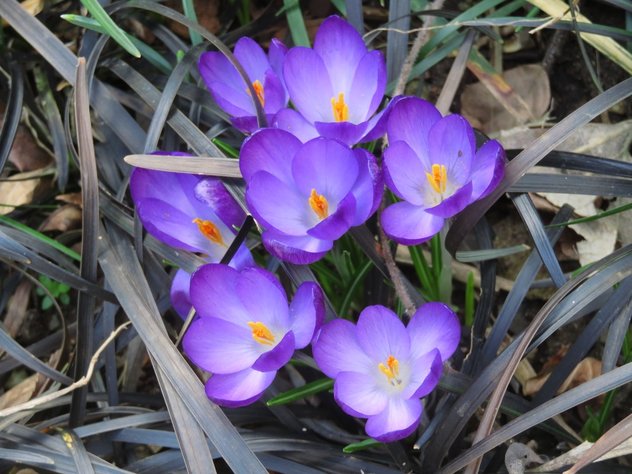CROCUS (Vernus?)
|
Crocus (Vernus?)
Common Names: Crocus, Dutch crocus, snow crocus. (English plural: crocuses or croci) Genus: Crocus Family: Iris (Iridaceae) Species: Crocus Vernus Type: Perennial Hardiness: Zones 3- 8 Bloom Time: Late winter - early spring. Exposure: Will vary slightly with varieties. Full sun to partial shade. As Crocus Vernus usually blooms late winter - early spring, they do best in full sun. Prefers cool climate, not heat tolerant. Height: Less than 6" (h) Spread: Approx. 6" Description: Genus of the family, comprising 90 species of perennials growing from corms. Leaves are semi-erect, thin, and lance-shaped, looking like blades of grass, with a center white stripe. They grow taller as the flowers fade. The narrow, cup shaped flowers have 6 petals and can be shades of white, purple and yellow, depending on the variety. Cultivation: Spring blooming crocus are planted in the early fall. Plant corms about 4 - 5 inches deep and 2 - 4 inches apart, pointed end up. It can sometimes be hard to tell which is the pointed end of a corm, but don't worry too much. The plant will grow toward the light. Adding bulb food will ensure they have the nutrients they need to get started. Crocus corms need a 12 - 15 week period of cold (35 to 45 degrees F.) temperatures, to set their blooms. They naturalize by corm offsets (baby corms on the sides of the originally planted corm) and sometimes, when mature and happy over time, by self-sowing seed. These corms have fibrous (reticulate) tunics. Plant about nine corms (bulbs) per square foot for a dense planting. (Square footage is determined multiplying the planting site’s length times its width.) Croci bloom and naturalize best where winters are cold. The flowers fade quickly in heat. Fertilizer: Crocus do not require a lot of fertilizer. Since croci store their own energy in their corms, do not cut back the leaves until they yellow on their own. If the soil is poor, spread a light top dressing of bulb food in the fall. Soil/pH: Crocus prefer a neutral soil pH of 6.0 - 7.0. More important than soil pH is good drainage. As with most bulb-like plants, crocus do not like to sit in wet soil, especially during the summer, when they are dormant. Watering: Water regularly in the spring and fall. If there is no snow cover, the corms will also need water throughout the winter. They go dormant during the summer and prefer a drier soil. Pests/Diseases: Crocus are attractive to squirrels and other rodents who feed on the leaves, plants, and corms. There are deterrents that can be sprayed on the leaves to prevent browsing. Plant corms in wire cages (available at garden centers or online) to protect the corms. Avoid using bone meal, which can attract rats, and try inter-planting your crocus with daffodils, which animals dislike. Crocus are also susceptible to viruses which can cause distortions, streaking and buds that fail to open. There is no cure for viral diseases. Dispose of the plants to prevent spreading the virus. Propogation/Transplanting: Croci seldom need dividing. In many areas they are somewhat short lived and need to be replanted every few years. However if your crocus do very well and start to multiply, they will eventually begin to bloom less. If this occurs, the corms may be divided and replantedwhen the foliage starts to die back. Notes/Gardening Tips: Crocus Vernus bloom about two weeks after Species Crocus, The hybrids tend to bloom a little later; mixing them with other species of crocus will produce a longer period of bloom. Crocus planted in a protected spot can bloom weeks earlier than those in open exposure, like a lawn. Planting them where other plants will fill in and hide their foliage will give the crocus a chance to store energy for the next season. For a more natural look, toss the corms onto the planting space and plant them where they land. The corms also do well in alpine and rock gardens and in containers. Crocuses are native to woodland, scrub, and meadows from sea level to alpine tundra in central and southern Europe, North Africa and the Middle East, on the islands of the Aegean, and across Central Asia to Xinjiang Province in western China. |

